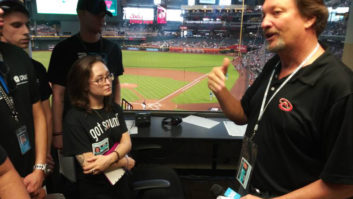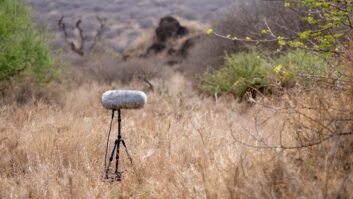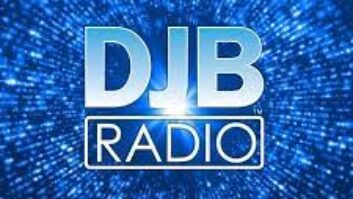
Turn a mic to the crowd, and make your broadcast more engaging. When mixing audio at a sporting event, broadcasters need to think in terms of the listeners rather than themselves.
It is my observation that a majority of small-market sportscasters do not understand the concept of deploying a crowd microphone.
Yes, we go to a lot of trouble to make radio studios quiet (as we should). The situation is much different when away from a studio.
Listeners should be treated to the sounds of what is happening, not just announcers’ voices. Remember, listeners tune into a sporting event on the radio because they cannot be there in person. It makes perfect sense to demonstrate the flavor of the scene by putting a microphone out to pick up crowd and action noises. So many times you hear announcers close-talking their microphones, so much so that you might think they were doing the broadcast from a studio rather than a baseball or football stadium.
Announcers must stop thinking that listeners are tuning in to hear them. Mix the audio so the listener feels he or she is sitting at the game.
If you were in the stands at a game and there was little or no crowd noise, you would feel there was something wrong. It is the sound of the crowd reaction and the clash of players or bats against balls that give a listener a more complete sensory experience.
Almost any inexpensive or beat-up old microphone will do to pick up crowd sounds. It doesn’t even need to have good frequency response.
The big guys will use a microphone just to pick up the crack of a bat at professional baseball games.
Basketball games are different. There is usually plenty of noise in the packed arenas, so an extra microphone is not normally needed.
Keep in mind that too much crowd noise can mask what an announcer is saying, and unfortunately that is bad too. Occasionally there is a situation where a crowd mic will hear a fan using four-letter words. Good microphone placement should more or less eliminate that problem, so I wouldn’t use that as an excuse not to use a crowd mic.
Our local high school football team competed for the state championship title last fall. I was in a car listening to the first half of the game. No crowd microphone was used and it sounded very dry. When I reached home and turned on a television I discovered the television folks had employed a crowd microphone. It was an entirely different sound and was a much more exciting game even when I closed my eyes to just hear the audio. (Did you get that? Television had better sound than radio!)
Again, sports announcers should not think of themselves first; instead, they should think of the listener. When they bring in crowd noise, they capture the spirit of the event and have an entirely different presentation.
BAD AUDIO
On another matter, more audio is not necessarily better — it is usually worse.
Watching VU levels is critical to keeping announcer audio clean. As an engineer, I have often been appalled at how bad audio can be from a game when it did not need to be if audio levels had been watched more closely. Mic gain should be set before the game for the loudest possible level when the announcer shouts during a touchdown, etc. Remote broadcast units typically do not have much audio headroom. Voice peaks can easily be clipped by running the audio into the red on a VU meter.
Listeners quickly will tire of distorted audio. Give the listeners a break and increase listener retention by keeping the audio clean. It makes a world of difference, especially for listeners who are only mildly interested in the event. Those people typically tune out from fatigue.
If you have the choice between more audio level or less audio level, less is better. Peak clipping distortion is an easy way to grate on listeners’ nerves.
A Modest Proposal
Let me offer a suggestion to those who are speaking before a live group or for video. This is becoming increasingly pertinent as more radio stations are encouraging broadcasters to use multimedia coverage for events.
Please hold the microphone away from your mouth. Much of the enjoyment is found in seeing someone speak. Covering a face with a microphone keeps viewers from experiencing the expressions and emphasis in a speech or song. Some of us supplement our hearing by reading lips.
If the microphone needs to be close, have it resting on the chin and talk over it. The sound will be just fine. Trust me. Television reporters do it that way, and everyone else should too. Pass this tip on to everyone you know. It makes perfect sense.
A similar situation happens when announcers close-talk a microphone to the point where breath noises and p-popping occurs. It’s not pleasant for the listener. Remember, radio is communication should be between one announcer and one listener at a time. That personal one-on-one relationship is a hallmark of the most successful announcers.
One way to help fix this problem is for sports announcers to listen to their own audio in an air check, just like studio announcers do. Sportscasters could learn something from that time-honored technique. If they sit back and listen to more than the game score, it might come to them that the listener is not hearing the game the way a fan would in the stands if he had a good buddy explaining the action to him.
Yes, sports announcers paint word pictures with narration, but the crowd reaction and play sounds are important parts of a broadcast. Best not to leave the extra sounds out.
Mark Persons WØMH, CPBE, has over 30 years’ experience. He has written numerous articles for industry publications over the years. Learn more at www.mwpersons.com.












